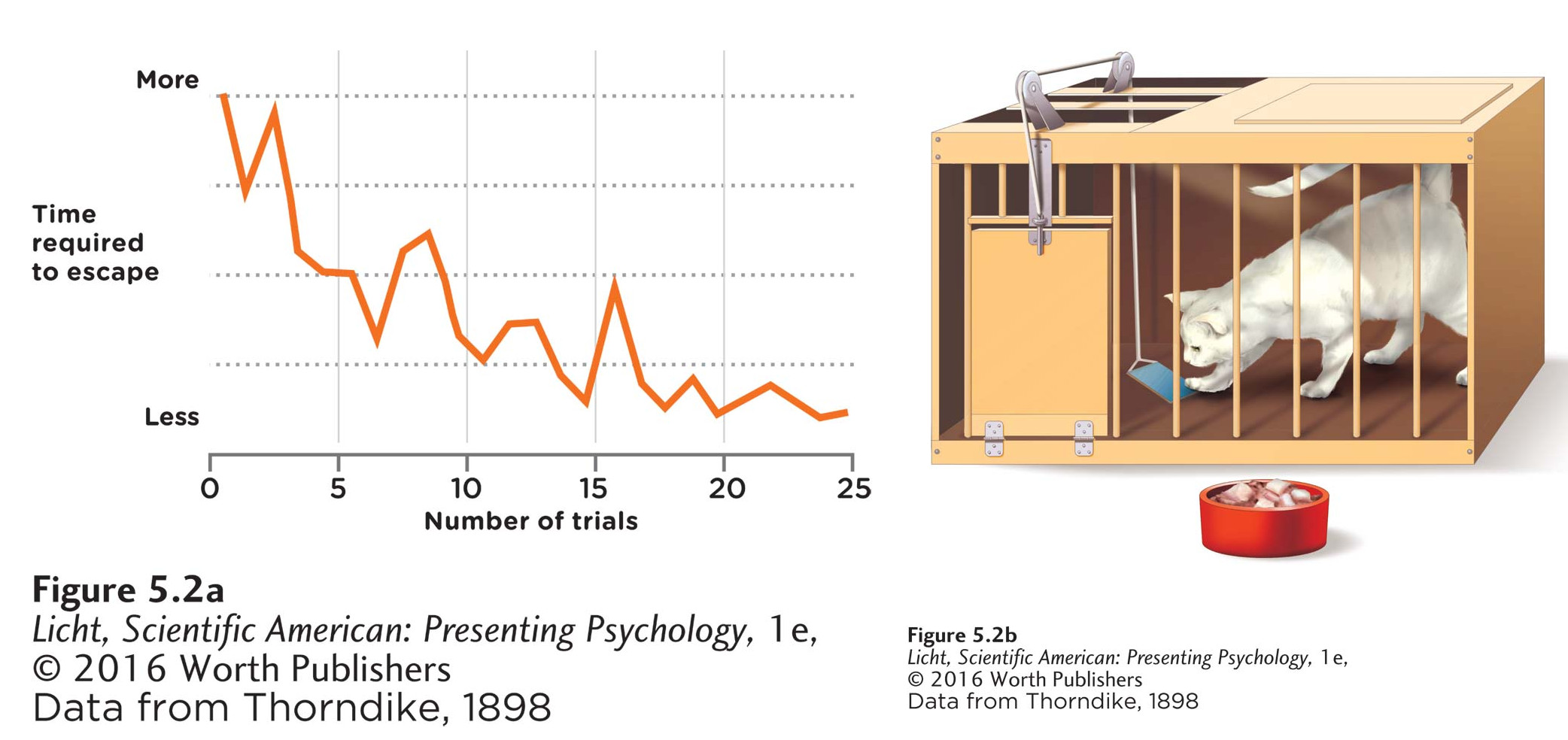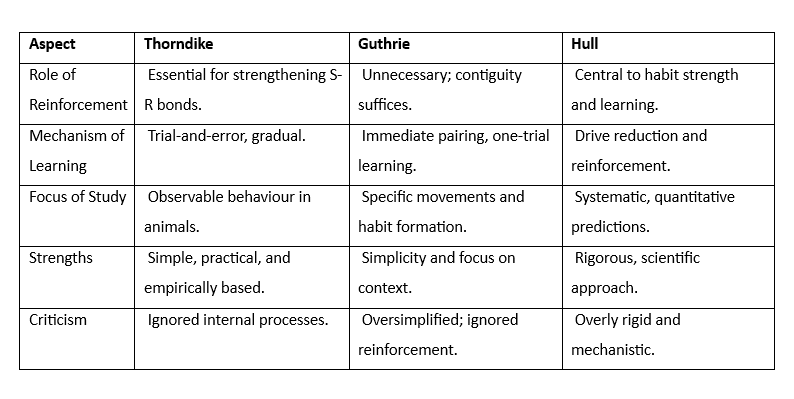Introduction
Stimulus-Response (S-R) theories focus on the connection between stimuli (environmental events) and responses (observable behaviors). These theories emphasize learning as the establishment of associations through direct interaction with the environment. Key proponents of S-R theories include Edward Thorndike, Edwin Guthrie, and Clark Hull.
S-R Theories
Stimulus-Response (S-R) theory of learning is a behaviorist framework that posits learning as the establishment of direct associations between stimuli (S) and responses (R). It emphasizes observable behaviors and excludes internal mental processes. Learning, according to S-R theories, occurs when an external stimulus elicits a specific response, and this connection is strengthened through repetition, reinforcement, or contiguity.
Core Principles of S-R Theory
- Association Building- Learning happens through the formation of direct bonds between stimuli and responses.
- Observable Behavior- Only outward behaviors are studied, avoiding speculation about unobservable mental processes.
- Reinforcement- Often considered necessary (e.g., Thorndike and Hull) to strengthen the S-R connection.
S-O-R theory introduces the organism (O) as a mediating factor between stimulus and response. Unlike S-R theory, it accounts for internal processes, such as perception, cognition, emotions, and motivations, which influence how a stimulus leads to a response.
S-S theory focuses on the association between two stimuli, rather than a stimulus and a response. It highlights the idea that learning involves cognitive processes, where one stimulus predicts or represents another stimulus, leading to an inferred response.
Read More- Learning
1. Thorndike’s Theory of Learning
Edward Thorndike was a groundbreaking psychologist who contributed extensively to educational psychology and the scientific study of animal behavior. He emphasized the importance of empirical research and observation, forming the basis for later behaviorist theories. His most significant contributions include the formulation of the laws of learning, particularly the Law of Effect, Law of Exercise, and Law of Readiness.
Puzzle Box Experiments (1898)
Thorndike designed a puzzle box to study animal behavior scientifically. Cats were placed in the box, which had a mechanism (e.g., a lever or string) that, when activated, opened the door to release the cat to access food.

Thorndike’s Puzzle Box
Findings-
- Trial-and-Error Behavior- Cats initially displayed random behaviors, such as scratching, pushing, or biting. Over time, they learned to focus on the action (e.g., pulling the string) that opened the door.
- Incremental Learning- Learning occurred gradually rather than through sudden insight, as evidenced by decreasing time to escape over successive trials.
- S-R Association- The specific stimulus (the box’s mechanism) became associated with the successful response (e.g., pulling the string).
Based on this experiment, Thorndike cam up with three important laws of learning which include-
1. Law of Effect
It states that the behaviors followed by satisfying outcomes (reinforcement) are more likely to recur, whereas behaviors followed by unpleasant outcomes (punishment) are less likely. The strength of the S-R bond depends on the nature of the consequences.
For example- In Thorndike’s puzzle box experiments, a cat trapped in the box engaged in various random behaviors. When it accidentally triggered the mechanism (e.g., pulling a string or pressing a lever), the door opened, and the cat received a reward (food). Over successive trials, the cat learned to associate the specific action with the outcome, escaping faster each time.
2. Law of Exercise
The Law of Exercise describes how repetition and practice influence learning. It is divided into two principles-
- Law of Use- Repetition strengthens the association between stimulus and response. For example- A student repeatedly practicing math problems strengthens their ability to solve them efficiently.
- Law of Disuse- Lack of repetition weakens the association. For example- A person who stops speaking a foreign language may gradually forget it.
Thorndike later revised the Law of Exercise, recognizing that repetition alone does not guarantee learning. Instead, the quality of reinforcement during practice is critical. This refinement aligned with emerging evidence showing that practice without understanding or motivation does not always lead to mastery.
3. Law of Readiness
The Law of Readiness emphasizes the learner’s preparedness to act. According to this law learning is most effective when the individual is physically and mentally ready to engage in a task. If a learner is ready but not allowed to act, frustration ensues. Conversely, if a learner is forced to act without readiness, it results in discomfort and resistance.
For example- A child who is ready to learn multiplication will engage positively and absorb the material efficiently. However, teaching multiplication to a child who hasn’t mastered basic addition and subtraction will result in confusion and frustration.
2. Guthrie’s Theory of Learning
Edwin Ray Guthrie was a prominent figure in the behaviorist tradition who proposed a streamlined explanation of learning. While Thorndike and other behaviorists emphasized the role of reinforcement, Guthrie introduced a more minimalist framework centered on contiguity—the temporal proximity of stimulus and response. His theory challenged the necessity of reinforcement, proposing that learning could occur with a single exposure when conditions were right.
Puzzle Box Observations (Guthrie & Horton, 1946)
Guthrie sought to replicate and expand upon Thorndike’s puzzle box experiments to understand the specific behaviors involved in learning. Cats were placed in a puzzle box that required them to perform an action (e.g., pressing a lever or pushing a latch) to escape and access food. The researchers recorded the precise movements cats used to achieve the goal.

Cats in a Puzzle Box (1946)
Findings
- Consistency of Movements- Cats developed specific, consistent movements (e.g., using a paw to push a latch) to escape the box. These movements became more refined with repetition, demonstrating the formation of an S-R bond.
- Lack of Generalization- Cats did not develop general strategies for solving similar problems. Instead, they focused on the specific actions associated with success in the puzzle box.
- Trial-and-Error Learning- Although Guthrie emphasized contiguity over reinforcement, the role of repeated exposure in refining movements was evident.
Contiguity Theory
The Contiguity Theory is the cornerstone of Guthrie’s approach. It posits that learning occurs when a stimulus (S) and a response (R) are paired closely in time. The temporal proximity of these events is sufficient to form an S-R bond.
- Principle of Temporal Proximity- When an individual experiences a specific stimulus and immediately performs a response, the connection is established. Reinforcement is not a necessary condition for learning in this framework; the mere co-occurrence of events is enough.
- Role of Repetition- While a single pairing can establish a basic S-R bond, repetition strengthens the association by reducing competing responses.
For example- A student who hears the bell ring (stimulus) and stands up to leave the classroom (response) forms a connection between these events. Repeated exposure strengthens this bond, making the response automatic.
One-Trial Learning
Guthrie’s concept of One-Trial Learning is a distinctive feature of his theory. He argued that learning could occur in a single exposure if the stimulus and response are strongly paired.
- Single Exposure Sufficiency- Unlike other theories that emphasize gradual learning through reinforcement, Guthrie believed that one well-timed experience could create an enduring S-R bond.
- Apparent Gradual Learning- Repetition does not deepen the initial bond but instead eliminates competing or irrelevant responses, making the learned response appear more consistent over time.
For example- A child burns their hand on a hot stove (stimulus) and quickly learns to avoid touching it (response). This learning occurs in a single trial due to the immediate and intense pairing of the events.
Habit Formation
Guthrie extended his theory to explain the development and modification of habits.
- Habit Formation- Habits emerge through repeated S-R pairings within specific contexts. Consistent exposure to the same stimulus with the same response solidifies the habitual behavior.
- Habit Breaking- To break a habit, the old response must be replaced with a new one in the same context. Simply avoiding the stimulus or suppressing the response is ineffective.
For example- A person develops the habit of biting their nails when feeling anxious. Replacing nail-biting with chewing gum during moments of anxiety can recondition the response.
3. Hull’s Theory of Learning
Clark L. Hull was a pioneering psychologist who sought to create a scientific and systematic theory of learning by integrating stimulus-response (S-R) associations with physiological and mathematical principles. His work is characterized by its rigorous attempt to quantify learning processes, making it one of the earliest efforts to create a comprehensive, testable model in behavioral psychology.
Rat Maze Experiments
Hull used rats in mazes to investigate the interplay between drives, reinforcement, and learning. Rats were placed in mazes with food rewards at the end. Hull manipulated variables such as the rats’ hunger levels and the frequency of rewards.
Findings
- Role of Drive Reduction- Rats navigated the maze faster when they were hungry (high drive). The presence of food rewards strengthened the S-R association.
- Learning and Motivation- Motivation (hunger) significantly influenced the rate and consistency of learning.
- Reinforcement and Habit Strength- Repeated success in finding food reinforced specific paths, increasing habit strength.
Drive Reduction Theory
Hull’s Drive Reduction Theory is a central aspect of his framework, positing that learning is driven by the reduction of biological and psychological drives.
- Drives are internal states of tension arising from unmet biological needs (e.g., hunger, thirst).
- Behaviors that reduce these drives result in satisfaction or relief, reinforcing the behavior and making it more likely to recure.
- When an organism performs a response that reduces a drive, the association between the stimulus and the response is strengthened.
For example- A rat in a Skinner box learns to press a lever because doing so results in food delivery. The food reduces the drive of hunger, reinforcing the lever-pressing behavior.
Habit Strength
Habit Strength (SHR) refers to the strength of the connection between a stimulus and a response. It is a key determinant of behavior in Hull’s model.
- Habit strength increases with reinforcement. Each time a behavior successfully reduces a drive, the association between the stimulus and the response becomes stronger.
- Without reinforcement, habit strength diminishes over time (extinction).
- Hull believed habit strength could be measured and used to predict the likelihood of a particular response under specific conditions.
For example- In a maze experiment, a rat that repeatedly finds food at the end of a particular path develops a strong habit of choosing that path.
Mathamathical Formula for Learning

- Positive Factors- sHr, D, K, V combine to increase sEr making the response more likely. These terms represent the strengths of learned behaviors, motivational states, rewards, and stimuli.
- Negative Factors- sIr and Ir subtract from sEr, reflecting temporary and conditioned inhibitory influences. These factors reduce the likelihood of a response due to fatigue, punishment, or lack of reinforcement.
- Oscillation (sOr)- The ±sOr term introduces variability into the model, acknowledging that behavior may not be perfectly predictable even with all other factors accounted for.
Comparision Between the Three Types of Learning

Comparision Between the S-R Theories
Conclusion
The Stimulus-Response (S-R) theories of learning, as exemplified by Edward Thorndike, Edwin Guthrie, and Clark Hull, have contributed significantly to our understanding of behaviorist psychology. Each theorist offered a unique perspective on how learning occurs and the role of reinforcement, contiguity, and motivation in shaping behavior.
References
Thorndike, E. L. (1898). Animal Intelligence: An Experimental Study of the Associative Processes in Animals. Psychological Review, 5(6), 177-184.
Guthrie, E. R., & Horton, N. A. (1946). The Psychology of Learning. Harper & Row.
Hull, C. L. (1943). Principles of Behavior: An Introduction to Behavior Theory. Appleton-Century-Crofts.
Skinner, B. F. (1938). The Behavior of Organisms: An Experimental Analysis. D. Appleton-Century.
Mace, F. C., & Belfiore, P. (2001). The Behavior-Analytic Approach to Learning. Journal of the Experimental Analysis of Behavior, 76(3), 393-413.
Matlin, M. W. (2019). Cognitive Psychology (9th ed.). Pearson Education.
Rachlin, H. (1995). The Science of Self-Control. Harvard University Press.
Hergenhahn, B. R., & Henley, T. (2014). An Introduction to the History of Psychology (8th ed.). Wadsworth, Cengage Learning.
Dr. Balaji Niwlikar. (2025, January 5). 3 Important Types of S-R Theories of Learning. Careershodh. https://www.careershodh.com/3-important-types-of-s-r-theories-of-learning/
